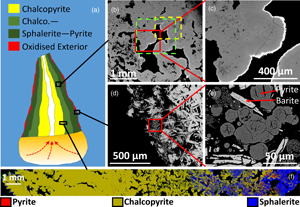Article contents
Investigation of the Internal Structure of a Modern Seafloor Hydrothermal Chimney With a Combination of EBSD, EPMA, and XRD
Published online by Cambridge University Press: 20 May 2020
Abstract

Samples from the sphalerite-dominated zone of a seafloor massive sulfide chimney, the Satanic Mills Chimney of the PACMANUS hydrothermal field, have been investigated to determine the internal macrostructure and microstructure of this zone, the phases present, and the distribution of metals. A combination of electron probe microanalysis, electron backscattered diffraction, and x-ray diffraction has been used. At the macroscale, this zone of the chimney wall is heavily porous and is comprised primarily of sphalerite, enclosing minor chalcopyrite, pyrite, and wurtzite. A Pb–As sulfosalt layer of possible microbial origins is present at the outer edge of the sphalerite matrix, next to a pore. The sphalerite has grown in globules on the order of 300 μm in diameter. At the microscale, the sphalerite features a colloform texture and a duplex-type grain structure consisting of either fine-grain regions in the center surrounded by coarse-grained regions or radiating coarse grains only. Pb- and As-rich bands have been detected in the colloform sphalerite, and growth twins have been observed in both the sphalerite and chalcopyrite crystals. A qualitative description of the growth of a typical globule is given, including nucleation, crystal growth, and solute redistribution.
- Type
- Australian Microbeam Analysis Society Special Section AMAS XV 2019
- Information
- Copyright
- Copyright © Microscopy Society of America 2020
References
- 4
- Cited by





